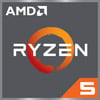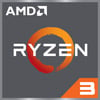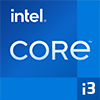
AMD Ryzen 5 1600 AF vs AMD Ryzen 3 3100
Last updated:
CPU comparison with benchmarks
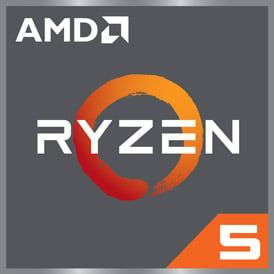
|
 |
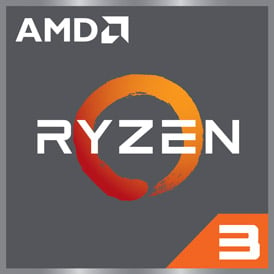
|
| AMD Ryzen 5 1600 AF | AMD Ryzen 3 3100 | |
CPU comparisonIn this CPU comparison, we compare the AMD Ryzen 5 1600 AF and the AMD Ryzen 3 3100 and use benchmarks to check which processor is faster.
We compare the AMD Ryzen 5 1600 AF 6 core processor released in Q4/2019 with the AMD Ryzen 3 3100 which has 4 CPU cores and was introduced in Q2/2020. |
||
| AMD Ryzen 5 (84) | Family | AMD Ryzen 3 (33) |
| AMD Ryzen 2000 (9) | CPU group | AMD Ryzen 3000 (15) |
| 2 | Generation | 3 |
| Pinnacle Ridge (Zen+) | Architecture | Matisse (Zen 2) |
| Desktop / Server | Segment | Desktop / Server |
| -- | Predecessor | -- |
| -- | Successor | AMD Ryzen 3 4100 |
|
|
||
CPU Cores and Base FrequencyThe AMD Ryzen 5 1600 AF is a 6 core processor with a clock frequency of 3.20 GHz (3.60 GHz). The processor can compute 12 threads at the same time. The AMD Ryzen 3 3100 clocks with 3.60 GHz (3.90 GHz), has 4 CPU cores and can calculate 8 threads in parallel. |
||
| AMD Ryzen 5 1600 AF | Characteristic | AMD Ryzen 3 3100 |
| 6 | Cores | 4 |
| 12 | Threads | 8 |
| normal | Core architecture | normal |
| Yes | Hyperthreading | Yes |
| Yes | Overclocking ? | Yes |
| 3.20 GHz | Frequency | 3.60 GHz |
| 3.60 GHz | Turbo Frequency (1 Core) | 3.90 GHz |
| 3.40 GHz | Turbo Frequency (All Cores) | 3.90 GHz |
Memory & PCIeUp to GB of memory in a maximum of 2 memory channels is supported by the AMD Ryzen 5 1600 AF, while the AMD Ryzen 3 3100 supports a maximum of 128 GB of memory with a maximum memory bandwidth of 51.2 GB/s enabled. |
||
| AMD Ryzen 5 1600 AF | Characteristic | AMD Ryzen 3 3100 |
| DDR4-2666 | Memory | DDR4-3200 |
| Max. Memory | 128 GB | |
| 2 (Dual Channel) | Memory channels | 2 (Dual Channel) |
| 42.7 GB/s | Max. Bandwidth | 51.2 GB/s |
| Yes | ECC | Yes |
| -- | L2 Cache | 2.00 MB |
| 16.00 MB | L3 Cache | 16.00 MB |
| 3.0 | PCIe version | 4.0 |
| 20 | PCIe lanes | 20 |
| 19.7 GB/s | PCIe Bandwidth | 39.4 GB/s |
Thermal ManagementThe AMD Ryzen 5 1600 AF has a TDP of 65 W. The TDP of the AMD Ryzen 3 3100 is 65 W. System integrators use the TDP of the processor as a guide when dimensioning the cooling solution. |
||
| AMD Ryzen 5 1600 AF | Characteristic | AMD Ryzen 3 3100 |
| 65 W | TDP (PL1 / PBP) | 65 W |
| -- | TDP (PL2) | -- |
| -- | TDP up | -- |
| -- | TDP down | -- |
| 95 °C | Tjunction max. | 95 °C |
Technical detailsThe AMD Ryzen 5 1600 AF has 16.00 MB cache and is manufactured in 12 nm. The cache of AMD Ryzen 3 3100 is at 18.00 MB. The processor is manufactured in 7 nm. |
||
| AMD Ryzen 5 1600 AF | Characteristic | AMD Ryzen 3 3100 |
| 12 nm | Technology | 7 nm |
| Chiplet | Chip design | Chiplet |
| x86-64 (64 bit) | Instruction set (ISA) | x86-64 (64 bit) |
| SSE4a, SSE4.1, SSE4.2, AVX2, FMA3 | ISA extensions | SSE4a, SSE4.1, SSE4.2, AVX2, FMA3 |
| AM4 (PGA 1331) | Socket | AM4 (PGA 1331) |
| AMD-V, SVM | Virtualization | AMD-V, SVM |
| Yes | AES-NI | Yes |
| Windows 10, Windows 11, Linux | Operating systems | Windows 10, Windows 11, Linux |
| Q4/2019 | Release date | Q2/2020 |
| 210 $ | Release price | -- |
| show more data | show more data | |
Rate these processors
Average performance in benchmarks
⌀ Single core performance in 4 CPU benchmarks
⌀ Multi core performance in 6 CPU benchmarks
Cinebench 2024 (Single-Core)
The Cinebench 2024 benchmark is based on the Redshift rendering engine, which is also used in Maxon's 3D program Cinema 4D. The benchmark runs are each 10 minutes long to test whether the processor is limited by its heat generation.
|
|
AMD Ryzen 5 1600 AF
6C 12T @ 3.60 GHz |
||
|
|
AMD Ryzen 3 3100
4C 8T @ 3.90 GHz |
||
Cinebench 2024 (Multi-Core)
The Multi-Core test of the Cinebench 2024 benchmark uses all cpu cores to render using the Redshift rendering engine, which is also used in Maxons Cinema 4D. The benchmark run is 10 minutes long to test whether the processor is limited by its heat generation.
|
|
AMD Ryzen 5 1600 AF
6C 12T @ 3.60 GHz |
||
|
|
AMD Ryzen 3 3100
4C 8T @ 3.90 GHz |
||
Cinebench R23 (Single-Core)
Cinebench R23 is the successor of Cinebench R20 and is also based on the Cinema 4 Suite. Cinema 4 is a worldwide used software to create 3D forms. The single-core test only uses one CPU core, the amount of cores or hyperthreading ability doesn't count.
|
|
AMD Ryzen 5 1600 AF
6C 12T @ 3.60 GHz |
||
|
|
AMD Ryzen 3 3100
4C 8T @ 3.90 GHz |
||
Cinebench R23 (Multi-Core)
Cinebench R23 is the successor of Cinebench R20 and is also based on the Cinema 4 Suite. Cinema 4 is a worldwide used software to create 3D forms. The multi-core test involves all CPU cores and taks a big advantage of hyperthreading.
|
|
AMD Ryzen 5 1600 AF
6C 12T @ 3.40 GHz |
||
|
|
AMD Ryzen 3 3100
4C 8T @ 3.90 GHz |
||
Geekbench 5, 64bit (Single-Core)
Geekbench 5 is a cross plattform benchmark that heavily uses the systems memory. A fast memory will push the result a lot. The single-core test only uses one CPU core, the amount of cores or hyperthreading ability doesn't count.
|
|
AMD Ryzen 5 1600 AF
6C 12T @ 3.60 GHz |
||
|
|
AMD Ryzen 3 3100
4C 8T @ 3.90 GHz |
||
Geekbench 5, 64bit (Multi-Core)
Geekbench 5 is a cross plattform benchmark that heavily uses the systems memory. A fast memory will push the result a lot. The multi-core test involves all CPU cores and taks a big advantage of hyperthreading.
|
|
AMD Ryzen 5 1600 AF
6C 12T @ 3.40 GHz |
||
|
|
AMD Ryzen 3 3100
4C 8T @ 3.90 GHz |
||
Cinebench R20 (Multi-Core)
Cinebench R20 is the successor of Cinebench R15 and is also based on the Cinema 4 Suite. Cinema 4 is a worldwide used software to create 3D forms. The multi-core test involves all CPU cores and taks a big advantage of hyperthreading.
|
|
AMD Ryzen 5 1600 AF
6C 12T @ 3.40 GHz |
||
|
|
AMD Ryzen 3 3100
4C 8T @ 3.90 GHz |
||
Estimated results for PassMark CPU Mark
Some of the CPUs listed below have been benchmarked by CPU-monkey. However the majority of CPUs have not been tested and the results have been estimated by a CPU-monkey’s secret proprietary formula. As such they do not accurately reflect the actual Passmark CPU mark values and are not endorsed by PassMark Software Pty Ltd.
|
|
AMD Ryzen 5 1600 AF
6C 12T @ 3.40 GHz |
||
|
|
AMD Ryzen 3 3100
4C 8T @ 3.90 GHz |
||
Cinebench R15 (Single-Core)
Cinebench R15 is the successor of Cinebench 11.5 and is also based on the Cinema 4 Suite. Cinema 4 is a worldwide used software to create 3D forms. The single-core test only uses one CPU core, the amount of cores or hyperthreading ability doesn't count.
|
|
AMD Ryzen 5 1600 AF
6C 12T @ 3.60 GHz |
||
|
|
AMD Ryzen 3 3100
4C 8T @ 3.90 GHz |
||
Cinebench R15 (Multi-Core)
Cinebench R15 is the successor of Cinebench 11.5 and is also based on the Cinema 4 Suite. Cinema 4 is a worldwide used software to create 3D forms. The multi-core test involves all CPU cores and taks a big advantage of hyperthreading.
|
|
AMD Ryzen 5 1600 AF
6C 12T @ 3.40 GHz |
||
|
|
AMD Ryzen 3 3100
4C 8T @ 3.90 GHz |
||
Geekbench 6 (Single-Core)
Geekbench 6 is a benchmark for modern computers, notebooks and smartphones. What is new is an optimized utilization of newer CPU architectures, e.g. based on the big.LITTLE concept and combining CPU cores of different sizes. The single-core benchmark only evaluates the performance of the fastest CPU core, the number of CPU cores in a processor is irrelevant here.
|
|
AMD Ryzen 5 1600 AF
6C 12T @ 3.60 GHz |
||
|
|
AMD Ryzen 3 3100
4C 8T @ 3.90 GHz |
||
Geekbench 6 (Multi-Core)
Geekbench 6 is a benchmark for modern computers, notebooks and smartphones. What is new is an optimized utilization of newer CPU architectures, e.g. based on the big.LITTLE concept and combining CPU cores of different sizes. The multi-core benchmark evaluates the performance of all of the processor's CPU cores. Virtual thread improvements such as AMD SMT or Intel's Hyper-Threading have a positive impact on the benchmark result.
|
|
AMD Ryzen 5 1600 AF
6C 12T @ 3.40 GHz |
||
|
|
AMD Ryzen 3 3100
4C 8T @ 3.90 GHz |
||
Cinebench R20 (Single-Core)
Cinebench R20 is the successor of Cinebench R15 and is also based on the Cinema 4 Suite. Cinema 4 is a worldwide used software to create 3D forms. The single-core test only uses one CPU core, the amount of cores or hyperthreading ability doesn't count.
|
|
AMD Ryzen 5 1600 AF
6C 12T @ 3.60 GHz |
||
|
|
AMD Ryzen 3 3100
4C 8T @ 3.90 GHz |
||
Blender 2.81 (bmw27)
Blender is a free 3D graphics software for rendering (creating) 3D bodies, which can also be textured and animated in the software. The Blender benchmark creates predefined scenes and measures the time (s) required for the entire scene. The shorter the time required, the better. We selected bmw27 as the benchmark scene.
|
|
AMD Ryzen 5 1600 AF
6C 12T @ 3.40 GHz |
||
|
|
AMD Ryzen 3 3100
4C 8T @ 3.90 GHz |
||
CPU-Z Benchmark 17 (Single-Core)
The CPU-Z benchmark measures a processor's performance by measuring the time it takes the system to complete all benchmark calculations. The faster the benchmark is completed, the higher the score.
|
|
AMD Ryzen 5 1600 AF
6C 12T @ 3.40 GHz |
||
|
|
AMD Ryzen 3 3100
4C 8T @ 3.90 GHz |
||
CPU-Z Benchmark 17 (Multi-Core)
The CPU-Z benchmark measures a processor's performance by measuring the time it takes the system to complete all benchmark calculations. The faster the benchmark is completed, the higher the score.
|
|
AMD Ryzen 5 1600 AF
6C 12T @ 3.20 GHz |
||
|
|
AMD Ryzen 3 3100
4C 8T @ 3.60 GHz |
||
Devices using this processor |
|
| AMD Ryzen 5 1600 AF | AMD Ryzen 3 3100 |
| Asus ROG GL702ZC-GC174T | Unknown |
Popular comparisons containing this CPUs
back to index





